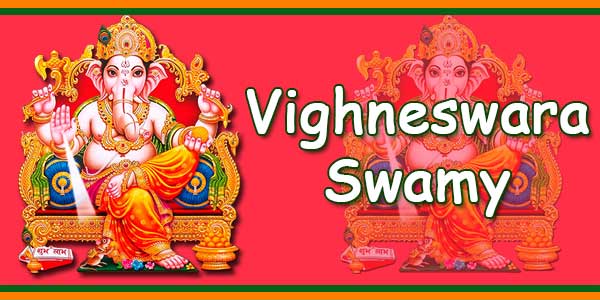Sri Ganesha is one of the most beloved deities and is the first deity to be worshiped as he can remove all obstacles. He is the patron saint of arts, crafts and sculpture. He is also considered a lord of Astrology, action and the god of the harvest (especially for sugar cane growers). Sri Ganesha has many names but Ganapati, Vinayaka, Vighneshwara and Ganesha are the popular names.
There are lot of symbolism attached to Ganesha Idols. There are a total of 32 forms of Ganesha. Importance is given to posture in Ganesha idols (sitting, standing, dancing or relaxed) and also to the direction of the trunk of Ganesha. Normally Ganesha is represented with 4 arms but in some Ganesha statues, he is represented with 2, 6, 8, 10 or 16 arms. on rare occasions, he is shown with 5 heads. in his hands, he is depicted with different objects depending on the role he plays. During the Ganesha Chaturthi festival, Ganesha statues are made with different creative themes and convey messages to devotees. Most people consider Ganesha to be single, but some people say Ganesha is married. so there is a lot of folklore and tales associated with Ganesha.
Regarding the symbolism of Ganesha, different people have interpreted it differently. Although they say more or less the same thing there is no consistency of thought. Here we have tried our best to interpret the symbolism associated with Ganesha after consulting many books and sources. We pray to Ganesha to guide us further in this direction to know the correct meaning.
22 Symbolism of Sri Ganesha:
- Trunk:- Symbolic of discrimination power (Viveka). ability to discriminate between right and wrong. flexibility in the trunk indicates that one should not be rigid and should be ready to adapt himself with time.
- Big Ears:- listen more and talk less. while listening digest only those things which are wise and discard all unnecessary things. it also indicates that he listens carefully to the prayers to his devotees.
- Small Mouth:- Talk less and only about what is essential.
- Big Head:- Wisdom and think big.
- Big Belly:- The whole world is contained in him. he accepts everything good or bad with the same equanimity. it represents the capacity to absorb all pleasant and unpleasant experiences of the world with grace.
- Single tusk:- One truth or non-duality. broken tusk indicates the imperfections of the ever-changing material world.
- Small Eyes:- The power of concentration. elephant eyes can even see small things even from a distance. because his eyes make them look big. so don’t judge or see things from a narrow perspective. don’t judge the book from its book cover. look at the bigger picture and at all angles while giving justice. it also indicates having foresight for the future.
- The Third Eye:- To see the world with spiritual wisdom.
- Modak:- symbolic of Gyana (enlightenment) which gives bliss.
- Tray of Ladoos at Ganesha Feets:- The luxuries of the whole world are at your feet. if you want then you can achieve them with determination. the mind (indicated by the mouse or your desires) will be obviously attracted to them. but you should follow the path of dharma. be a lotus in this world.
- Four Hands:- Lord Ganesha is often shown with four hands.
a) First hand is always giving blessings to his devotees and assuring them of fearlessness. it also indicates that he can fulfill the desires of his devotees.
b) Second hand contains rice ball which indicates the sweet fruit of spiritual sadhana.
c) Noose-bearing hand – it represents many things. first of all, all worldly desires are a noose. Secondly, with the Noose Ganesha catches the delusion and frees his devotees from its effects. Thirdly he uses Noose to pull his devotees close to the truth and bind them to the god.
d) Ankusha (elephant goad) bearing hand:- represents his power and ability to direct his devotees on the right path. - One leg resting on the ground and the other leg folded up:- The leg on the ground indicates that we need to perform our worldly duties (duties of a householder). the leg pointing upwards indicates that in midst of doing these worldly duties we should not forget the divinity within us (god). do your duties but side by side remember god also. don’t lose track of the real purpose of life in this materialistic world.
- Mouse:- Symbolic of worldly desires and passions which need to be overcome.
- Lotus:- Symbol of purity. stay in the world yet don’t get attached to the materialistic world.
- Crescent Moon:- Auspicious time to do things. it also represents that this third-day crescent moon without blemishes will lead to spiritual growth and attainment of moksha.
- Veena:- symbolic of nada-brahman, the ever pervading music of the universe.
- Snake:- Kundalini shakti which we all need to awaken in this lifetime.
- Hammer:- He is the patron of arts, crafts and sculptors.
- Sugarcane:- Elephant’s favorite food is sugarcane. similarly, the soul hankers for liberation. It’s not easy to break the shell of the ego (like sugarcane) but once broken then the result is very sweet.
- Axe:- Used for cutting worldly attachments and desires of devotees thus freeing them from sorrow and pain.
- Om:- The cosmic sound which represents brahman (supreme knowledge or supreme soul). ganesha has realized the brahman and is the deity who controls the Muladhara Chakra where kundalini shakti resides. ganesha has the power to unlock the kundalini shakti.
- Swastika:- mark of auspiciousness, good luck and fortune.
